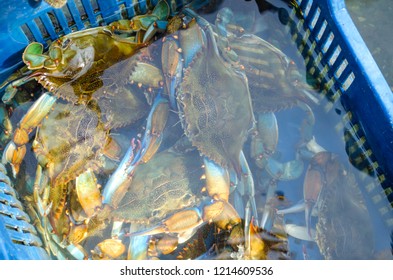
Two of the most popular methods are with crab pots and by "Handlining."Ĭrab pots aren't actually pots - they are wire boxes that resemble chicken coop cages. When it comes to non-commercial crabbing, there are quite a few methods on the Outer Banks.
Catch blue crab license#
Otherwise, a Recreational Commercial Gear License (RCGL) is required. Individuals do not need a license to use collapsible crab traps so long as the largest open dimension is no larger than 18 inches and the traps are designed to collapse at all times when in the water, except when they are being retrieved from or lowered to the bottom. Individuals do not need a license for chicken necking or legging. A private pier or shoreline means there is no public access and does not apply to fishing piers where the public pays for fishing privileges. Individuals do not need a license to set one pot per person from a private pier or shoreline, so long as he has permission of the property owner. But many first-time visitors are surprised to learn that crabbing, though a little tricky, can be easily conducted off the soundfront backyards or waterfront docks of a vacation rental home, anytime of day, and nearly any time of year.įor a home caught dinner that's fresh off the docks, or a new way to enjoy the abundance of Outer Banks fishing and seafood, try a little crabbing on your next beach vacation.īefore you start, you'll need to check whether you'll need a North Carolina Fishing License, which is distributed by the North Carolina Wildlife Resources Commission and can be purchased online before your vacation, or at the majority of local Outer Banks tackle shops. The Outer Banks is notorious for its large supply of Blue Crabs, and these crabs wind up on the menus and Specials boards of Outer Banks restaurants all along the coast. Going catfishing soon? Make sure you have your fishing license.The Outer Banks is clearly known for its exceptional fishing, but for sporty vacationers who want to try something new, or take on an outdoors activity the entire family can enjoy, crabbing is a fun way to get your toes wet in the local Outer Banks fishing scene. This is when you should lower the tip 12 to 18 inches, reel quickly, and set the hook. When a catfish takes the bait there’s usually a momentary slackening of pressure on the rod tip. Usually there will be a 2-foot leader from the sinker (or swivel below the sinker) to the hook. Different sinker styles can be employed, some of which slide freely on the line. In a river most anglers anchor upstream of the place to be fished and fish a bait directly downstream, using a heavy enough weight to stay on the bottom. Also, still fishing or drifting with bait are most likely to produce fish. Make sure your presentations are on the bottom.īecause blue catfish are bottom dwellers and bottom feeders, and are especially adapted to smelling forage, lures are much less effective than natural or processed bait. Yes, this species is sometimes caught suspended in the water column, but that is far from the norm.

Catch blue crab how to#
How to Catch Blue CatfishĪtop the list of blue catfish fishing tips would be this: fishing on the bottom is essential. Deep holes and pools throughout a river are prime blue catfish habitat. The riprap along shorelines below a dam is also good, especially early in the season. The area below a dam, with gouged holes and turbulent water, is often a prime place to find blue catfish, especially a deep hole just below a hump. Blue catfish bait includes live and dead natural baits (whole or chunked/cut), even rotten ones, as well as the smelliest stink bait concoctions, chicken parts, strong cheeses, and more. Blue crabs are also a popular item in brackish environments, in part because they are often abundant. Assorted shad and herring species are a primary food in places where they exist. Highly omnivorous, blue catfish eat various specious of fish as well as crabs, clams, crayfish, and snails. This may vary by location the upper parts of some rivers are strictly freshwater while the lower reaches are brackish leaning to higher salinity in the estuary. The first step in determining how to catch blue catfish is to understand what they eat, and especially what is most abundant locally.

In these locations, which are rich with forage, they can grow extremely large. Blue catfish are commonly found in rivers, large impoundments, and in the big water below those impoundments.


 0 kommentar(er)
0 kommentar(er)
